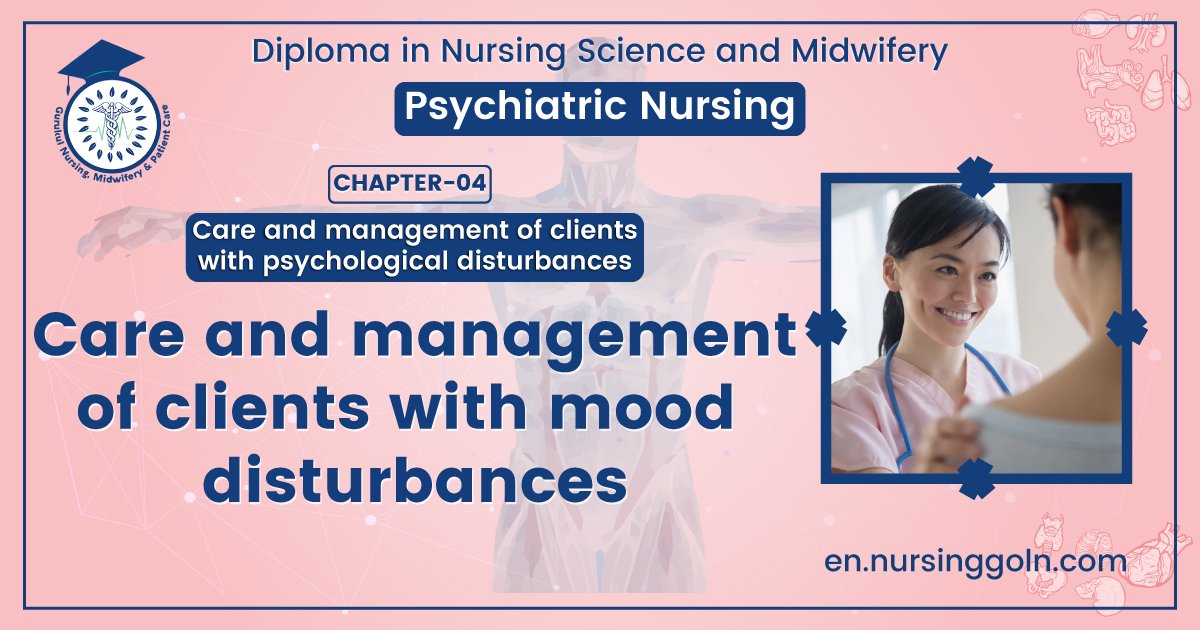Care and management of clients with mood disturbances – This book covers the entire syllabus of “Psychiatric Nursing” prescribed by the Universities of Bangladesh- for Basic and diploma nursing students. We tried to accommodate the latest information and topics. This book is an examination-friendly setup according to the teachers’ lectures and examination questions.
At the end of the book previous university questions are given. We hope in touch with the book students’ knowledge will be upgraded and flourish. The unique way of presentation may make your reading of the book a pleasurable experience.

Care and management of clients with mood disturbances
Mood:
Internal emotional state of an individual.
[Ref: KP Neeraja/I/Vol-2/389)
Or
A pervasive and sustained emotion that colours the perception of the world. Common examples of mood include depression, elation, anger and anxiety.
[Ref-Maya George/2/1921
Classification of mood with example:
| Mood | Example |
| Sad | Depression |
| Fear | Phobia |
| Elevated | Mania |
| Anxious | Anxiety neurosis |
| Flat | Schizophrenia |
| Irritable | Hypomania |
Mood disorder:
Mood disorder is a condition whereby the prevailing emotional mood is distorted or in appropriate to the specified circumstances.
Or
[Ref: KP Neeraja/1/Vol-2/390)
A mood disorder is a mental health problem that primarily affects a person’s emotional state. It is a disorder in which a person experiences long periods of extreme happiness, extreme sadness, or both.
Classification of mood disorder:
1. Unipolar disorder-Recurrent episodes of depression or mania.
- Major depression
- Recurrent depression
- Psychotic depression
- Dysthymia
- Postpartum depression
2. Bipolar disorder-Recurrent episode of depression and mania
- Type I Bipolar-Episodes of mania and major depression
- Type II Bipolar-Episodes of mania, hypomania and major depression
- Type III Bipolar-Episodes of major depression
- Type IV Bipolar-Consists of all other forms of bipolar disorders.
3. Affective disorders
4. Manic depressive psychosis
5. Mania
6. Depression
7. Circular reactions
8. Involutional psychotic reactions
[Ref: KP Neeraja/I/Vol-2/389)
Etiology of mood disorder:
Biological Factors:
Heredity:
1. Genetic predisposition is common, life time risk is noticed in first degree relatives of the client. If one parent suffers, 25 per cent chance for children to have the disorders, if both parents are suffering 50-75 percent chances to occur in children.
2. Neurophysiological factor
3. Imbalance in excitatory and inhibitory processes may predispose MDP. Obliteration of excitatory functions leads to mania, inhibitory functions may lead to depression.
Physical Factors:
1. Viral infection
Biochemical factors:
1. Imbalances in catecholamine (Norepinephrine, dopamine) levels or its functions obliterate results into MDP. If catecholamine amounts are increased mania, will occur, decreased levels predisposes for depression.
2. Deficiency in serotonin levels results in MDP.
3. Deficiency in GABA, acetylcholine contributes for mania occurrence.
Neuro-hormonal factors:
1. Decreased cortisol secretions; alteration in hippocampus functions predisposes for MDP.
2. Due to non-adrenergic receptors dysfunction in nocturnal period, alteration in pineal gland hormonal secretion (melatonin hormone) results into MDP (Excess secretion leads to mania decreased secretions leads to depression).
IL. Social factors
1. Stressful life events, traumatic or unpleasant or disturbing life experiences
2. Social pressures
3. Rejection of children by parents
4. Difficult or strained interpersonal relationships, interpersonal loss, interpersonal role dispute or transition or deficits
5. Socio-cultural factors
6. Loss of loved one (real or symbolic)
7. Financial difficulties
8. Unemployment, poor job opportunities
9. Criticism and rejection
10. Failures in life, defeat, hardship in scholastic environment
11. Faulty interactions within the social environment
12. Environmental stress
13. Uncontrollable events or factors
14. Maladaptive behaviour
15. Unhealthy comparison
16. Parental influence
17. Trying to escape from reality.
18. Physiological Factors
19. Feeling of helplessness, hopelessness, inadequate, worthlessness
20. Premorbid personality pattern-ambitious, energetic, social, will not express hostile feelings, endomorphic in their built, uncontrollable impulsive behaviour, lack of energy, breakdown under stress, introversion, insecurity, tendency to worry always, dependency, obsessionality.
21. Psychoanalytical factors-hostility, loss, conflicts within the self, borderline personality traits predisposes for depression
22. Expecting failure, defeat and hardship
23. Negative cognitions, ie. negative expectations of environment, self, future.
(Ref: KP Neeraja/1/Vol-2/392/)

Epidemiology of mood disorder:
- Six months prevalence of major depression in community is between 2 & 5%
- Life time rate 10-20%.
- Mean age of onset is 27 Years.
- Major depressions are twice as great in woman as man.
- There may be increase rates of depression in people born since 1945.
- Rate high in unemployment, divorced and substance misuser and anxiety disorder.
[Ref-A.K. Moyeenuddin Ahmmed/ 1 /40 and Lecture of ART NC
Treatment of mood disorder:
Hospitalization: If patient is too excited, is a public nuisance and unable of taking care of himself, then hospitalization is essential.
Drug therapy:
A. Antipsychotic drugs:
✓ Heloperidol
✓ Chlorpromazine(opsonil, largectil)
B. Anti manic drugs:
✓ Lithium-used in both acute stage and in preventing relapse.
✓ Na valproate prophylaxis in bipolar disorder.
✓ Carbamazepine (tegretol) mainly prevention of recurrences in bipolar illness.
✓ Lamotrigine & quetiapine are increasing being used
C. Anti depression drugs
D. ECT (electroconvulsive therapy)
[Ref-Davidson’s/22/245]
Drugs used in mood disorder:
| Name of the drugs | Dose |
| Haloperidol | Injection haloperidol 5-10 mg IM 2 hours by till the patient is sedated |
| Chlorpromazine | Injection chlorpromazine 50-100 mg IM |
| Carbamazepine | 600-1800 mg/day |
| Sodium valproate | |
| Lithium |
Nursing management of mood disorder:
The person suffering from manic disorder is an overactive individual with an excessive amount of energy. The patient is easily stimulated mentally and physically. The patient may react to this stimulation by constantly being excited, domineering, irritable or vulgar. His attention is easily distracted. Feelings of aggression and hostility are directed outward, to the environment. The overactive patient might be extremely likeable, talkative and euphoric.
Dict:
1. Special attention must be given to the patient’s diet because he is usually too busy to eat and hence may lose weight and dehydration may occur.
2. Meals and fluids are to be given under supervision.
3. Extra nourishment maybe required to compensate for extra activity.
Medications:
Drugs are of great help in dealing with problems of restlessness, sleeplessness and fatigue associated with over activity.
Physical Needs
1. Reduce physical activities and provides adequate sleep
2. Improve diet and fluid intake
3. Protect the patient from injury to self and others
4. Reduce verbal activity.
5. Pursue the patient to attend to personal hygiene.
6. Psychosocial Needs
7. Improve judgment
8. Improve attention and concentration
9. Improve communication
10. Appropriate socialization
11. Realistic self-concept.
Emotional needs;
1. Frequent mood changes and excitement may be there.
2. Approach the patient in a calm, unhurried and consistent manner.
3. Always speak quietly, tactfully and patiently.
4. Avoid arguments, discussions or situations that are stimulating and irritating.
5. Suggestions and persuasion are more effective.
6. One nurse should establish rapport with one overactive patient and improve his confidence in her.
7. Short, simple direct answers should be quietly given when the patient asks questions.
8. Maintain a low level of stimuli in the patient’s environment.
9. Observe the patient’s behavior frequently. Remove all dangerous objects from patient’s environment, so that in his or her hyperactive, agitated state they cannot be used to harm self or others.

Maintaining a therapeutic environment:
1. The ward must be quiet and pleasant.
2. Factors that irritate the patient like excessive noise, bright colors, etc. are to be avoided.
3. Separate rooms may be ideal with simple furnishing.
4. Fluctuation of mood states must be watched.
5. Active games, ward occupation and creative work will channelize his energy.
6. Drug therapy is essential for sedation.
Others:
1. Supervision is necessary for adequate nutrition and rest.
2. Bursts of excitement and destructive actively may result in injuries.
3. Therefore, they should be observed and attended.
4. Supervision and directions to maintain personal hygiene like bathing, oral hygiene are essential.
5. Care to be taken that the patient is dressed appropriately.
[Ref: S Nambi/24/84-86]
Read more:
